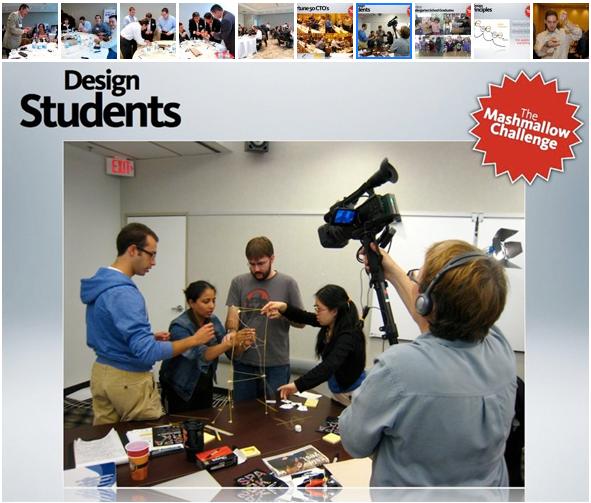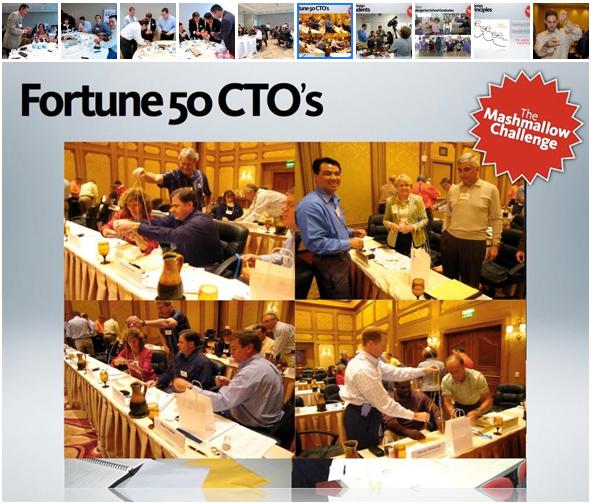Great Marshmallow challenge
Your Mission…….
The task is simple: in eighteen minutes, teams must build the tallest free-standing structure out of 20 sticks of spaghetti, one meter of tape, one Meter of string, and one marshmallow. The marshmallow needs to be on top.
The tools & Materials
✦Spaghetti - 20 pieces
✦String: - 1 Meter
✦Tape - 1 Meter
✦Marshmallow - 1 (on top hopefully)
✦Time - 18 minutes
Instructions
✦Build the Tallest Freestanding Structure: The winning team is the one that has the tallest structure measured from the table top surface to the top of the marshmallow. That means the structure cannot be suspended from a higher structure, like a chair, ceiling or chandelier.
✦The Entire Marshmallow Must be on Top: The entire marshmallow needs to be on the top of the structure. Cutting or eating part of the marshmallow disqualifies the team.
✦Use as Much or as Little of the Kit: The team can use as many or as few of the 20 spaghetti sticks, as much or as little of the string or tape. The team cannot use the paper bag as part of their structure.
✦Break up the Spaghetti, String or Tape: Teams are free to break the spaghetti, cut up the tape and string to create new structures.
✦The Challenge Lasts 18 minutes: Teams cannot hold on to the structure when the time runs out. Those touching or supporting the structure at the end of the exercise will be disqualified.
✦Ensure Everyone Understands the Rules: Don’t worry about repeating the rules too many times. Repeat them at least three times. Ask if anyone has any questions before starting.
Wrap up
•After the clock runs out, ask everyone in the room to sit down so everyone can see the structures. Likely, just over half the teams will have standing structures.
Marshmallow challenge lessons
Best Kindergarten School Graduates
Design students
Fortune 500 CTO's.
MARSHMALLOW CHALLENGE TRANSCRIPT
Several years ago, a design exercise called the Marshmallow Challenge was introduced. Its goal was simple: in eighteen minutes, teams of four must build the tallest freestanding structure out of 20 sticks of spaghetti, one yard of tape, one yard of string, and one marshmallow. The marshmallow has to be on top.Though the task seems simple, it's actually pretty hard. It forces people to collaborate quickly. So I decided to run it as part of a design workshop. And it was huge success. There was something about the exercise that reveals the true nature of collaboration. Since that first workshop, I've conducted over 70 Marshmallow challenges with designers, architects, students - even leadership teams of the Fortune 50.
Most participants discovered deep lessons on how to successfully they personally innovate. And I'd like to share some of these lessons with you.
LESSON 1:
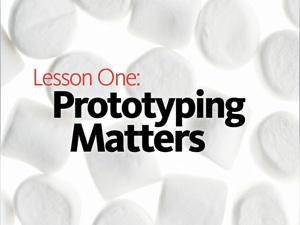
PROTOTYPING MATTERS.
Normally most people begin by orienting themselves to the task. They talk about what the finished structure might look like, and who does what. Then the team plans. They sketch, lay out spaghetti sticks and describe the best ways build the structure. Next, they assemble the sticks and tape them into ever growing structures. And finally, just as the time is running out, someone takes the marshmallow and gingerly places it on top of the fragile structure. They anticipate that they stand back 'ta-dah!!!' .But usually, the 'ta-dah' turns into an 'oh-oh!!' The weight of the marshmallow causes the structure to buckle and collapse .Some teams consistently have more 'oh-oh' moments than others. Among the worst are recent graduates of business school. It's actually amazing to watch them: They fight. They cheat. They produce lame structures.Some teams consistently have more 'ta-dah' moments. Among the better teams are recent graduates of kindergarten. Not only do they consistently produce taller structures, theirs look like trees, and elephants and spiders.But why? Peter likes to say that none of the kids spend their time trying to be CEO of spaghetti inc. But there's another reason. Business students are trained to create a single right plan, then execute on it. When they put a marshmallow on top and the structure topples over, there's no time to fix it and that creates a crisis! Sound familiar?
Among the worst are recent graduates of business school. It's actually amazing to watch them: They fight. They cheat. They produce lame structures.Some teams consistently have more 'ta-dah' moments. Among the better teams are recent graduates of kindergarten. Not only do they consistently produce taller structures, theirs look like trees, and elephants and spiders.But why? Peter likes to say that none of the kids spend their time trying to be CEO of spaghetti inc. But there's another reason. Business students are trained to create a single right plan, then execute on it. When they put a marshmallow on top and the structure topples over, there's no time to fix it and that creates a crisis! Sound familiar?  Kindergardners work differently. They build a little structure, add the marshmallow. They play around and add some more spaghetti stick. Again and again, they build prototypes each step of the way, always keeping the marshmallow on the top.
Kindergardners work differently. They build a little structure, add the marshmallow. They play around and add some more spaghetti stick. Again and again, they build prototypes each step of the way, always keeping the marshmallow on the top.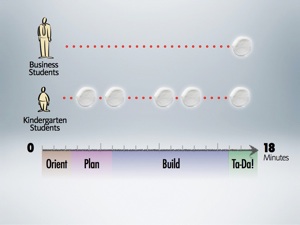 Designers recognize this type of collaboration as the essence of the iterative process - which is central to design thinking. With each version, the kids get instant feedback of what works and what doesn't. Through play and prototyping, they instantly adapt to what's in front of them.
Designers recognize this type of collaboration as the essence of the iterative process - which is central to design thinking. With each version, the kids get instant feedback of what works and what doesn't. Through play and prototyping, they instantly adapt to what's in front of them.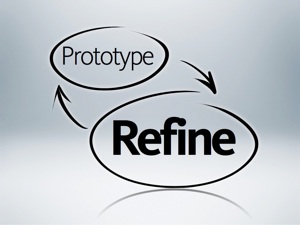
LESSON 2:
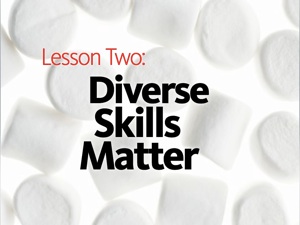 DIVERSE SKILLS MATTER
DIVERSE SKILLS MATTER
The capacity to play and prototype are important skills for innovation. But there are others too.
+ The average height for most teams is just over 20 inches.
+ Business students average about half.
+ Lawyers do a bit better. But not much better. Like business students, they spend too much time seeking power and making plans.
+ Kindergartners, as we've seen, do better than most adults.
+ And who does the very best?
+ Thankfully - Engineers and Architects - create the tallest stable structures. So far, the largest I've seen is 39 inches. Architects and Engineers have specialized skills and experiences. They know that triangles and self-reinforcing geometrical patterns produce the most stable spaghetti towers.
+ CEOs are bit better than average.
+ But here's where it gets interesting. If an executive administrator works with the CEO team, that team almost always wins. It seems that the admin's skills of facilitation makes a big difference. Any team member who pays close attention the process of work - encouraging timing, improving communication, cross pollinating ideas - increases the teams performance significantly.
Winning teams are specialists. But the next best are those with facilitation skills.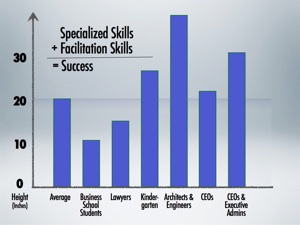
LESSON 3:
INCENTIVES MAGNIFY OUTCOMES
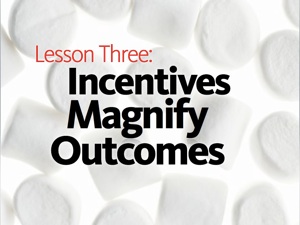 In management theory, there's a popular concept that incentive always improves performance. The marshmallow challenge tells us something else. Here's a typically performance curve for ten teams competing against each other. On average, six teams build standing structures and four fail.
In management theory, there's a popular concept that incentive always improves performance. The marshmallow challenge tells us something else. Here's a typically performance curve for ten teams competing against each other. On average, six teams build standing structures and four fail. 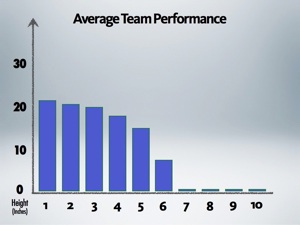 Some months ago, just as I was about to start a marshmallow challenge to a group of 40 design students, I thought, "Why not up the ante?" So I offered ten thousand dollars of software to the winning team. And so what do you think happened?
Some months ago, just as I was about to start a marshmallow challenge to a group of 40 design students, I thought, "Why not up the ante?" So I offered ten thousand dollars of software to the winning team. And so what do you think happened?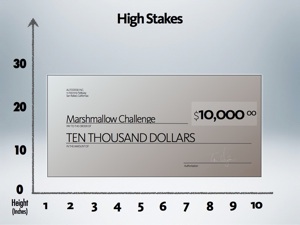 Here are the results: Not one team had a standing structure. Every tower collapsed. If anyone had built, say, a one inch structure, they would have taken home the prize. Four months later, we tried again. This time the students knew about the value of prototyping. The teams went from being the very worst to among the very best. They produced the tallest structures in the least amount of time.
Here are the results: Not one team had a standing structure. Every tower collapsed. If anyone had built, say, a one inch structure, they would have taken home the prize. Four months later, we tried again. This time the students knew about the value of prototyping. The teams went from being the very worst to among the very best. They produced the tallest structures in the least amount of time. 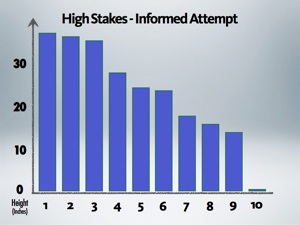 So the lesson here is that incentives alone are not enough.High incentives with low skills can actually kill performance. But high incentives with high skills - specialized or facilitation - can lead to high success.
So the lesson here is that incentives alone are not enough.High incentives with low skills can actually kill performance. But high incentives with high skills - specialized or facilitation - can lead to high success.
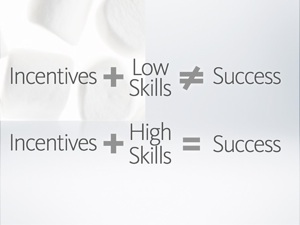
WHY CONDUCT THE MARSHMALLOW CHALLENGE?
So why would anyone actually spend time running the marshmallow challenge? I help create digital tools for teams who create cars, bridges, consumer products, movies and videogames and much more. The marshmallow challenge helps them identify hidden assumptions lurking within their real projects. Every project has its own marshmallow!!! The marshmallow challenge provides teams with a shared felt experience, a common language and a solid stance to find the right prototypes to build their real projects successfully, to avoid the oh-oh moments and have real ta-dah moments. If you're interested in running your own Marshmallow Challenge you can visit a blog called Marshmallow Challenge dot com - one word. You'll find instructions on how to run the challenge, strange and bizarre solutions, the results of challenges from around the world. And if you conduct a challenge, you can share your experiences with others. The fundamental lesson, I believe, is that Design is a contact sport. It demands that we bring all of our senses to the task and applying the very best of our thinking, feeling and doing to the challenge. Sometimes a little prototype of this experience is all we need to take us from oh-oh to ta-da.Thank you.


